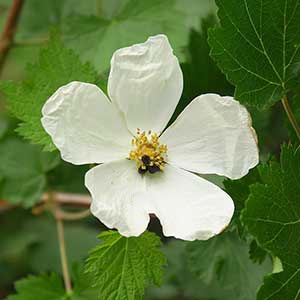Rubus bartonianus
Rubus parvifolius
Barton's raspberry, bartonberry
Australian raspberry or bramble, Japanese bramble, Japanese raspberry
erect, sparsely short-hairy, glabrescent, eglandular, not pruinose.
biennial, low-mounding to creeping, sparsely to moderately hairy, glabrescent, eglandular, not pruinose;
prickles sparse to moderate, slightly to strongly hooked, weak to stout, 0.8–1.5(–2) mm, broad-based.
deciduous, simple;
stipules lanceolate, 4–6 mm;
blade cordate to broadly ovate, (2–)2.5–4(–5) × (2.5–)3.5–4.5(–5.5) cm, base deeply cordate, 3–5-lobed, lobe apices acute to obtuse, margins coarsely doubly dentate, abaxial surfaces glabrous or sparsely hairy, eglandular or sparsely stipitate-glandular.
deciduous, ternate or pinnately compound;
stipules filiform to linear, (4–)6–11 mm;
leaflets 3(–5), terminal broadly ovate-rhombic to obovate, (2–)3–5(–9) × 2.2–5(–7.5) cm, base cuneate to obtuse, slightly 3-lobed, margins coarsely serrate to doubly serrate, apex acute to obtuse, abaxial surfaces with slightly to strongly hooked prickles on veins, densely whitish-tomentose, eglandular or sparsely short-stipitate-glandular.
1-flowered.
terminal and axillary, 2–20-flowered, cymiform to thyrsiform.
moderately hairy, eglandular or sparsely stipitate-glandular.
prickles moderate, slightly to strongly hooked, moderately hairy, eglandular or sparsely short-stipitate-glandular.
bisexual;
petals white, obovate, (15–)20–25 mm;
filaments filiform;
ovaries glabrous, styles clavate, villous.
bisexual;
petals pinkish to magenta, oblanceolate to obovate, 4–7 mm;
filaments filiform;
ovaries moderately to densely hairy, styles glabrous.
deep red, hemispheric, to 1 cm;
drupelets 10–30, coherent, separating from torus.
red, round, 0.6–0.9 cm;
drupelets 10–50, strongly coherent, separating from torus.
= 14.
Rubus bartonianus
Rubus parvifolius
Of conservation concern.
Rubus bartonianus is distinguished from the other flowering raspberries within its geographic range by its erect, unarmed stems, relatively small, simple leaves with acute to obtuse lobes, deeply cordate bases, sparsely hairy or glabrous abaxial surfaces, relatively large flowers with white petals, and densely long-hairy, clavate styles. The leaves superficially resemble those of Acer glabrum or some species of Ribes.
Rubus bartonianus is most similar to R. neomexicanus but especially R. deliciosus. The species is known only from the Snake River Canyon of Idaho and Oregon.
(Discussion copyrighted by Flora of North America; reprinted with permission.)
Rubus parvifolius is distinguished from other raspberries by its broadly ovate-rhombic to obovate leaflets and relatively small flowers with pinkish to magenta petals. This species has the potential to become a very significant weed (P. M. Drobney and M. P. Widrlechner 2012).
(Discussion copyrighted by Flora of North America; reprinted with permission.)


